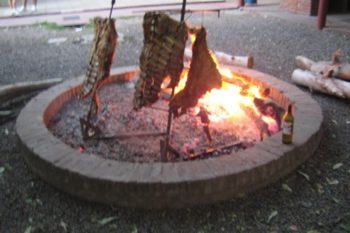Since the only legally binding marriage is the civil one, weddings in Argentina require a bit more paperwork. One needs to book a date at the nearest Registry Office, provide IDs, undergo a medical test at the nearest public hospital (can’t go private) and bring the results before the day of the wedding. Civil weddings take place on weekday mornings. It is usual to organize a celebratory lunch for close friends and family afterwards.
It goes without saying that civil weddings are carried out in Spanish. It was fine by my then-fiancé because he had lived in Buenos Aires for a few years but his family didn’t speak the language. One of my closest friends, who is a conference interpreter, was going to do the honours but she was taken ill and was in hospital.
We invited everyone to my parent’s home for lunch. I was disappointed in the weather because it had been sunny and warm until the day before and now it was overcast, cold and miserable. Murphy’s Laws never fail, right?
Religious weddings are optional. Ours took place on the Saturday after the civil ceremony. We got married at the town’s church, where most of my family either got married or was christened, and which is right next door to my old school. It meant a lot to me since we moved abroad shortly afterwards.
Although the ceremony was mainly in Spanish, we included passages in English so that everyone could participate.
The wedding reception consisted of eating, drinking, dancing, more eating, more drinking and more dancing. We started with cocktails and finger food followed by a three-course meal. Sean’s elder brother gave the wedding toast in English (with a Spanish translation, of course). Later, many guests told me they felt they were in a film. Speeches are not customary in Argentina; we only see them on films or TV series! We also cut the cake and drank champagne.
Traditionally, the first dance is a waltz but we danced to the great Stevie Ray Vaughan. We waltzed after that and our parents joined us first and then many of our guests. With that, we opened the disco. Even my 86-year-old grandfather hit the dance floor! The carnaval carioca is a fun part of the night: everyone wears silly hats, throws confetti and dances as if possessed.

Getting ready for the carnaval carioca
Breakfast (yes, breakfast!) consisted of coffee or tea and medialunas. This signalled the end of the reception, at about 5.30 am on Sunday morning. Rather early for an Argentinean wedding.
Read about weddings from Costa Rica, Okinawa (Japan) and India in our weddings around the world series.







This looks like so much fun. And your dress is lovely. By the way, what kind of cake was it? Not fruit cake I guess 🙂
@Liz: nope, it wasn’t fruit cake. I chose a layer of fresh cream and strawberries and a layer of dulce de leche 🙂
This sounds like fun! I like the part about the speeches being in english and spanish! these days, we too need to have a civil marriage for the records, but its more a matter of filling up forms, hanging around the court till the official deigns to call us, paying him a bribe to reduce our waiting time and just signing the records…viola! we have a certificate!
Very nice Ana! 🙂 You two look great and very happy! Btw, was your husband wearing traditional clothes from England? It’s so cool!
Thanks, Nuria. No, not English but Scottish. It’s his mother’s clan’s tartan, Ancient Ferguson.